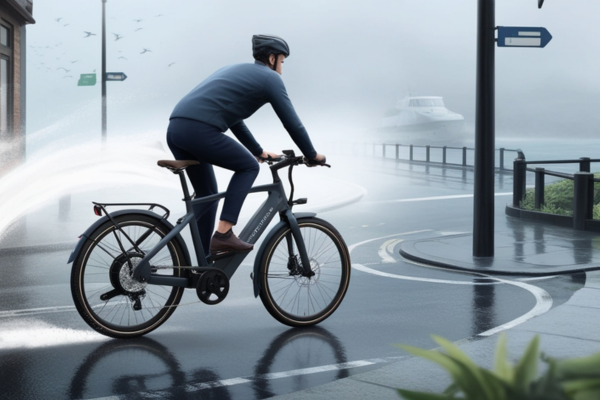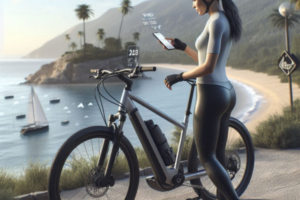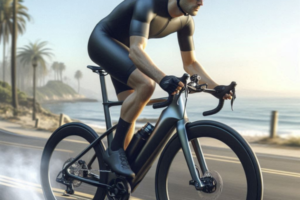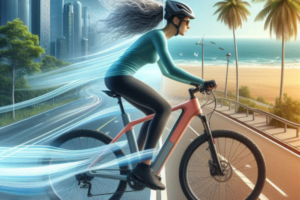💨 How Wind and Humidity Reduce E-Bike Efficiency
Wind resistance is one of the biggest performance challenges for electric bicycles — especially in humid environments. While traditional bikes are affected by wind at high speeds, e-bikes operate consistently within those ranges, making aerodynamic drag a constant factor. Add in the effects of humidity, and the situation becomes more complex.
Humidity increases air density, which in turn amplifies drag. The motor must push harder against heavier, moisture-rich air. At the same time, wet gear and clothing increase weight and frontal area, further reducing your efficiency.
🌫️ Why Coastal Conditions Demand More From Your E-Bike
Riding in coastal or humid environments introduces specific aerodynamic and mechanical challenges:
- Increased drag: Humid air is thicker, which slows down your bike
- Corrosion: Salt and moisture cause deterioration in metal components
- Battery drain: Wind resistance forces the motor to use more energy per kilometer
- Clothing drag: Wet clothing reduces your aerodynamic profile
These conditions combine to make your e-bike work harder and require more frequent maintenance.
🧰 How to Protect Your E-Bike in Humid Coastal Climates
Humidity doesn’t just affect performance — it can damage your e-bike over time. To reduce wind resistance and avoid long-term issues, follow these maintenance practices:
- Clean and dry your bike after every ride, especially metal parts
- Apply anti-corrosion protectants to bolts, screws, and exposed elements
- Use sealed bearings to block out moisture
- Store your bike indoors or under a cover
- Use a protective coating or wax on painted surfaces to reduce drag and corrosion
🚴♀️ Choose Bikes with Smarter Wind-Resistant Designs
Not all electric bicycles are equally suited for windy, humid conditions. Look for design elements like:
- Integrated cabling: Reduces surface turbulence
- Slim, aerodynamic frame shapes: Cuts through the air more efficiently
- Lightweight components: Help reduce effort against wind
- Internal battery housing: Less bulk and better balance
Choosing a bike with a corrosion-resistant frame and sealed electronics ensures long-term performance and safety in coastal conditions.
🧩 Accessories That Help You Cut Through Wind
Accessories play a big role in aerodynamics. Even small additions can increase drag if not chosen carefully. For humid and windy environments, consider:
- Low-profile panniers instead of wide baskets
- Integrated lighting systems instead of clip-on lights
- Rear racks with minimal surface area
- Fenders designed to channel water efficiently
Avoid accessories that flap in the wind, such as loose bags, reflectors on straps, or cloth covers.
🛠️ Smart Riding Habits for Windy Conditions
Your riding technique can make a huge difference in aerodynamic efficiency. Here are some proven strategies:
- Lower your body and keep arms and legs tight to the frame
- Reduce speed slightly when riding directly into headwinds
- Take advantage of natural wind breaks like buildings or tree lines
- Ride in consistent straight lines to avoid overcorrection
- Avoid carrying items on your back — use the frame instead
⚙️ Electric Bicycles Optimized for Wind Resistance and Humidity
When selecting an electric bicycle for use in humid, coastal areas, look for models that feature:
- Corrosion-resistant materials: Like anodized aluminum or carbon fiber
- Aerodynamic frame geometry: Designed to reduce drag even in crosswinds
- Water-sealed components: Including motor housing, bearings, and controllers
- Extended battery capacity: To compensate for extra resistance in windy areas
These types of e-bikes offer smoother, more energy-efficient rides and require less maintenance in humid, coastal environments.
🧠 Final Thoughts: Efficiency Begins with Awareness
Wind and humidity are unavoidable in many riding environments, but their impact doesn’t have to be. By choosing the right components, practicing regular maintenance, and adopting aerodynamic techniques, you can preserve battery life, ride faster, and enjoy smoother trips — even in challenging coastal conditions.
What’s your favorite trick to cut through the wind on your e-bike? Let us know in the comments!



